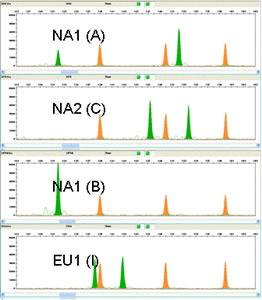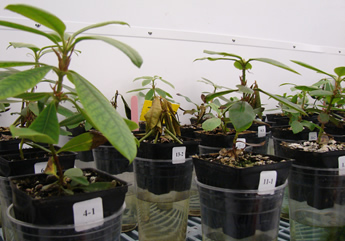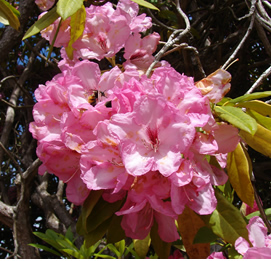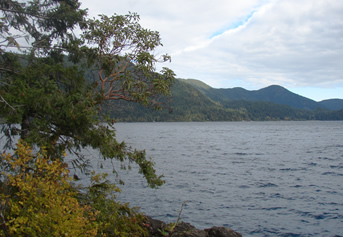Meeting Minutes
Attending:
(WSU-Puyallup) Marianne Elliott, Gary Chastagner, Annie DeBauw, Gil Dermott, Katie Coats, Kathy Riley ; David Wetzel, Puyallup High School ; Dan Omdal, Depart. of Natural Resources plant pathologist ; Cindy Cooper, WSDA; Erica Cline, UW Tacoma; John Browning, Weyerhaeuser plant pathologist ; Wanda Booth and Nancy Steel, King Co. Master Gardeners; Peg Tillery, Kitsap Co. Beachwatcher program
The purpose of the stream monitoring study was discussed. Early detection of P. ramorum and baseline information about Phytophthora spp present in streams are two goals of the project. Also expanding to cover areas not being monitored by WSDA and DNR.
The first order of business was to select 4 stream sites for baiting. One person in each location will be responsible for organizing volunteers for baiting. Baits will be deployed and retrieved at two week intervals for six baiting periods. Proposed locations include:
- Poulsbo stream in Kitsap County (Dogfish Creek?) location where Dan Omdal baited for 4 years. This site has been negative for P. ramorum, suggesting that the nursery upstream has been successful in eradicating P. ramorum when it was found in 2006. The stream has consistent water levels and is located near a medical office with good public access. Peg Tillery said she would be in charge of organizing this site.
- Clarks Creek at either a location near 56 th Street E. or possibly at Dan Picha property off of West Stewart where Dave Wetzel’s students have worked before. Dave will check with Dan to see if he is willing to have a bait site there. Erica Cline will coordinate with Dave in order to also have UW Tacoma students involved at this site.
- King County, near Redmond, at either Evans Creek which has housing developments nearby, or Peters Creek. Wanda Booth will be organizing this location.
- Olympia, Thurston County, near the Johnson Point area, was proposed by Cindy Cooper. Marianne will look into finding volunteers to monitor in this area.
- There were technical difficulties in communicating with Snohomish County, but if they want to select a stream and organize volunteers it will be included in the study.
A site in Clark County was also mentioned, but it was decided that that was too far to go this year and may be added in the future.
Organizers will get back to Marianne by next week with their decisions/information on locations.
The logistics of leaves, bags, duration of exposure, collection days, etc were discussed. Annie DeBauw will be in charge of distributing leaves to organizers at the proper times. We will be using fully expanded (mature) rhododendron leaves of the cultivar ‘Nova Zembla’ which WSU uses in its experiments and that they have readily available at Puyallup and will be providing to the volunteers. The baits will be put out ~ 6 times beginning the last week of February at 2-week intervals at the 4 sites using 4 rhody leaves for each baiting. Stream temperatures will be taken either on a continuous basis with a sensor that is placed in the bait bag or with a thermometer at the time of sample collection. The timing of the bait removal and renewal may change to a shorter or longer period depending on changing stream temperatures, how the rhody leaves are holding up, symptoms or lack of infection, vandalism, etc, over the course of the 12-week period. The most likely days for the bait change will be Wednesday for Puyallup High School (Clarks Creek) and Monday for the other 3 sites. This will allow plenty of time for samples to be received at WSU for processing. In addition, the extra slot in the bait bag can be used for a leaf of another species of the organizer’s choice as kind of “just out of curiosity” study.
Dan Omdal suggested leaving the bait bags in place and that when leaves are collected, they should be rinsed in the stream to remove any external sediment or other crud before transporting them. The likely method of storage will be between moist paper towels in a plastic baggie, but we will go over the collection and shipping process at the time of training at each of the sites, which will take place during the last week of February at the time the first bags are put out. Instructions for handling and shipping the baits will be provided in a manual for volunteers.
Master Gardener diagnosticians (and possibly students) who will be involved with sample processing at WSU Puyallup will receive training on laboratory methods at a time to be determined, probably the second week of March when the first bait samples will be processed. In future, Katie Coats may also possibly have opportunities for students to work on DNA sequencing.
Peg Tillery noted that there are online forms for WSU volunteers that keep track of their hours and that could be used for our records. This is important information for getting grants. This would include the high school student volunteers. Those that volunteer need to sign up so that they are covered under WSU for Labor and Industries insurance. WSU is holding a training session on volunteer reporting in Feb. and we will know more about procedures after that.
Marianne will also be keeping the SOD website up-to-date, so she will need lists of dates and personnel that can be posted on the website. All of data will also be put on the site, including maps of finds. She will send a link to you when that website location is ready. You can email her information to put on the calendar and website.
This is the year to “get the bugs out of the system”. WSU has applied for an NSF grant to start in 10/2010 for a 3-year study of Phytophthora biodiversity in forest settings using a stream baiting system. The collaboration with volunteer groups is an important element of this proposal and the stream site number would go up to 10. Other “jobs” this year involve someone to scout out more possible sites and possible projects to monitor water quality. Peg Tillery noted that the Stream Team in Kitsap Co. is already doing some of that kind of monitoring and she will check with them to see what kind of data they are taking.
Erica Cline is interested in some extra projects that Gary Chastagner would like to do in conjunction with this year’s work. They involve testing Rhododendron macrophylum leaves, which Dan Omdal has used in his baiting work, versus the ‘Nova Zembla’ leaves to determine if there are any differences in handling the leaves, etc. Also, he would like to do a 2-week vs. 4-week baiting mini-test. Both of these would take place at Clarks Creek.



